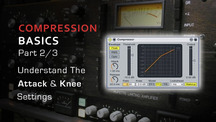The first post in this series looked at the main function of a compressor and how you can modify that function with the Threshold and Ratio settings. This time around we'll look at another couple ways you can modify a compressor's main function - via the Knee settings and Attack.
Knee
So what is the Knee? Well essentially this relates to how the gain reduction (as determined by the Threshold and Ratio we talked about last time) is implemented. In standard compression, nothing happens at all to your signal as it approaches your threshold, but once it does, the full gain reduction kicks in. This is referred to as "hard-knee compression".
Other types of compressor utilise "soft knee compression". In this case, the gain reduction is brought in progressively, so when the signal comes within 10dB or so of your threshold, the compressor starts to apply gain reduction with a very low Ratio setting, so there's very little effect. As the input level increases, the compression Ratio is automatically increased until at the Threshold level, the Ratio has increased to the amount you have set on the Ratio control.The overall result of this type of compression is a more gentle degree of control for signals that are hovering around the Threshold point, and therefore the he signal sounds less obviously processed.
So, when to use which right?
Well, the more gentle approach of soft-knee makes it useful for processing complete mixes or other sounds that need subtle control and where you don't want an obvious effect. On the other hand, hard knee will be more usefull when you need a more heavy approach to tame hard peaks in things like percussion or other material with abrubt and large peaks.
Fortunately, you should have the option to set your knee on your compression these days, so set your threshold and ratio as you see fit and then tweak the knee to suit the material, using your ears.
ATTACK
The attack time controls how long your compressor takes to pull the gain down once the signal has passed your set threshold . With a fast attack setting, the signal is controlled almost immediately. If you set a slower attack, this will allow the beginning of the sound to pass through unchanged before the compressor reigns it in.
So why do this? Well, by letting the earliest parts of a sound through by setting an attack time of several milliseconds you can enhance the percussive characteristics of instruments such as guitars or drums.
For your general purposes, an initial attack setting of between 1 and 20 milliseconds should suffice.
Original source here.












